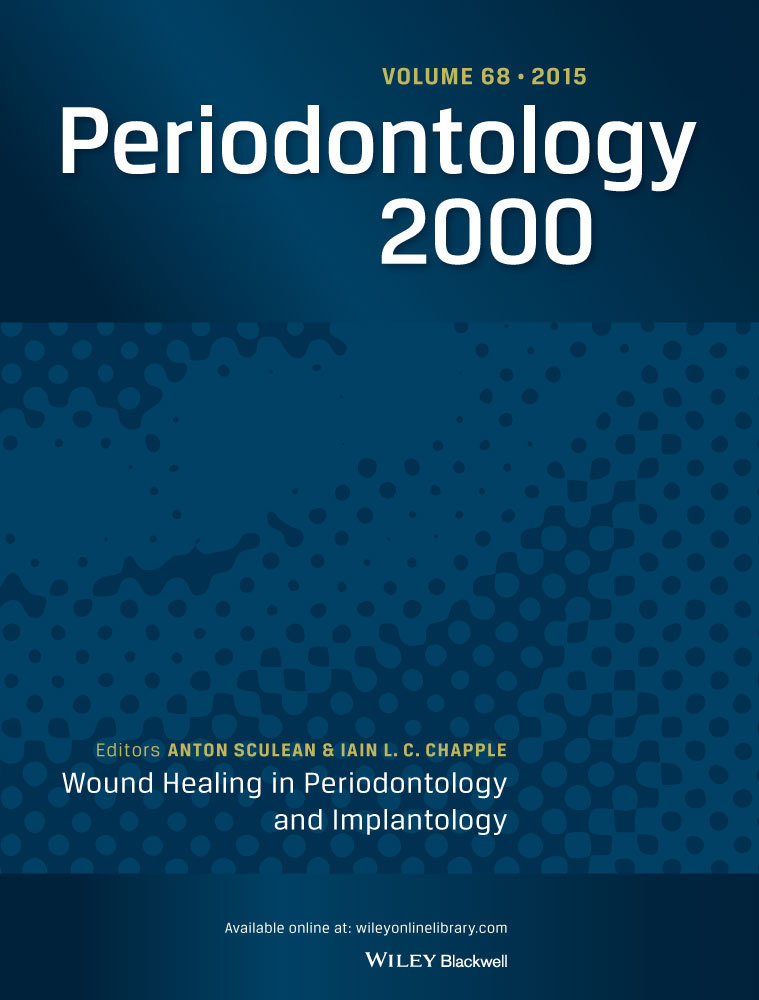The efficacy of biologic factors on the surgical therapy of periodontal suprabony defects: A systematic review and network meta-analysis of randomized clinical trials.
IF 15.7
1区 医学
Q1 DENTISTRY, ORAL SURGERY & MEDICINE
引用次数: 0
Abstract
OBJECTIVES This systematic review investigated the efficacy of biologic factors in the surgical treatment of periodontal suprabony defects. MATERIALS AND METHODS Three databases were searched to identify RCTs comparing open-flap debridement (OFD) combined with biologic factors only, or combined with bone substitute, and/or barriers to the same intervention without biologics or OFD in terms of probing pocket depth (PPD) reduction, clinical attachment level (CAL) gain, and number of pockets closed. Risk of bias was performed according to RoB 2. Pairwise meta-analyses and frequentist network meta-analyses by using random-effects models were performed. GRADE was employed to assess the certainty of evidence. RESULTS Ten studies reporting on 253 subjects were included. Overall, adding biologics to OFD leads to a significant improvement in post-treatment PPD and CAL at 9-12 months, with enamel matrix derivative (EMD) having the highest probability of being the best biologic for changes in PPD (-1.91 mm, 95% CI: -3.02, -0.81) and CAL (-2.24 mm, 95% CI: -2.68, -1.79) at a low level of evidence. CONCLUSION The addition of biologics provides an adjunctive benefit in post-treatment PPD and CAL. However, data should be interpreted with caution due to the heterogeneity of studies, limited data available, risk of bias, and low/moderate evidence.生物因素对牙周上颌骨缺损手术治疗的影响:随机临床试验的系统回顾和网络荟萃分析。
目的探讨生物因素在牙周颌骨上缺损外科治疗中的作用。材料和方法检索三个数据库,以确定比较开放皮瓣清创(OFD)仅联合生物因素,或联合骨替代物,和/或在不使用生物制剂或OFD的情况下进行相同干预的rct,在探查袋深度(PPD)减少、临床附着水平(CAL)增加和关闭袋数量方面。偏倚风险按照RoB 2进行评估。采用随机效应模型进行两两元分析和频率网络元分析。GRADE用于评估证据的确定性。结果纳入10项研究,共253名受试者。总体而言,在OFD中添加生物制剂可显著改善治疗后9-12个月的PPD和CAL,在低证据水平下,牙釉质基质衍生物(EMD)最有可能成为PPD变化的最佳生物制剂(-1.91 mm, 95% CI: -3.02, -0.81)和CAL (-2.24 mm, 95% CI: -2.68, -1.79)。结论:生物制剂的加入为治疗后PPD和CAL提供了辅助益处。然而,由于研究的异质性、可获得的数据有限、偏倚风险和低/中等证据,应谨慎解释数据。
本文章由计算机程序翻译,如有差异,请以英文原文为准。
求助全文
约1分钟内获得全文
求助全文
来源期刊

Periodontology 2000
医学-牙科与口腔外科
CiteScore
34.10
自引率
2.20%
发文量
62
审稿时长
>12 weeks
期刊介绍:
Periodontology 2000 is a series of monographs designed for periodontists and general practitioners interested in periodontics. The editorial board selects significant topics and distinguished scientists and clinicians for each monograph. Serving as a valuable supplement to existing periodontal journals, three monographs are published annually, contributing specialized insights to the field.
 求助内容:
求助内容: 应助结果提醒方式:
应助结果提醒方式:


